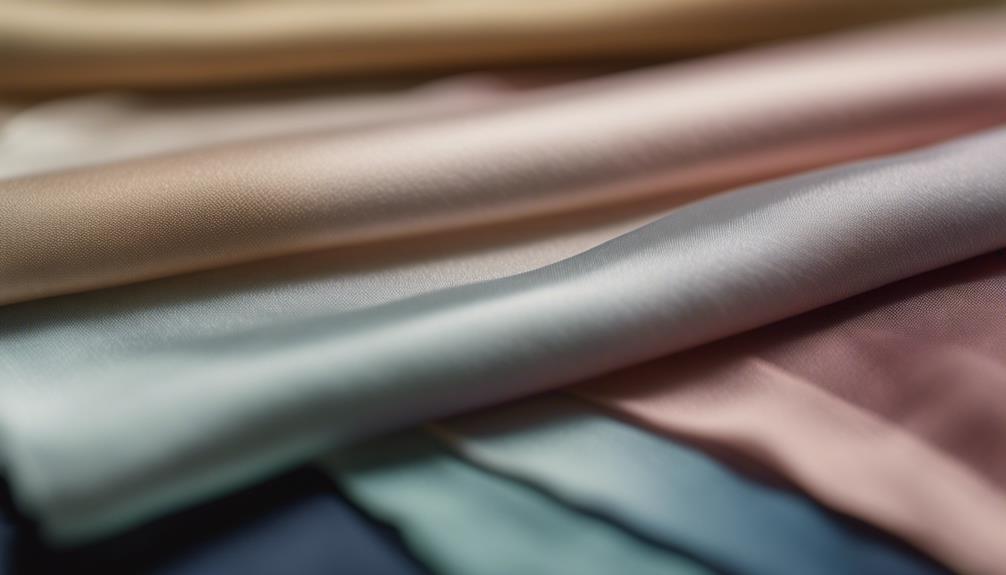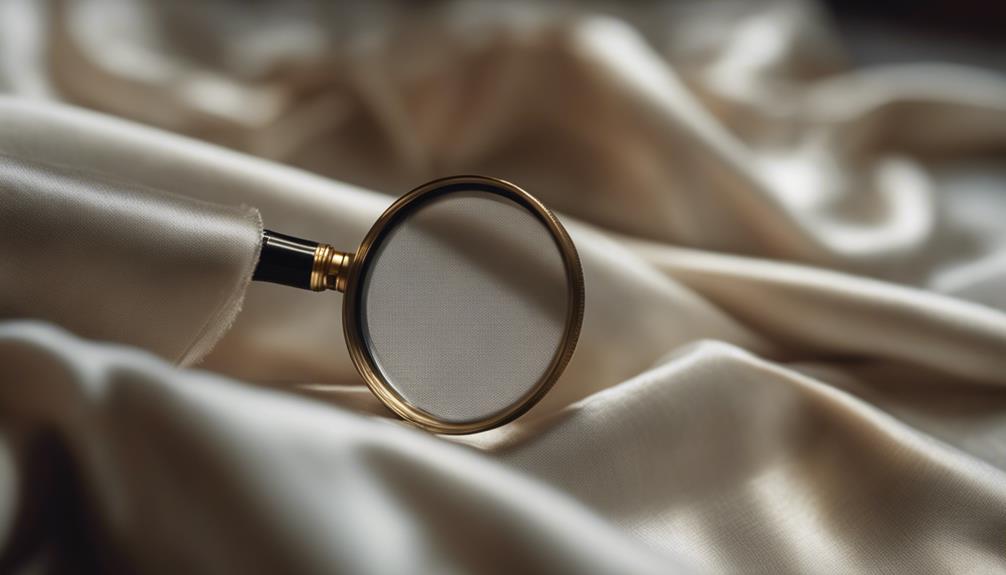To identify silk, start by checking labels for "100% Silk." Look for its unique sheen; real silk reflects multiple colors, while synthetic appears overly shiny. You can also perform a burn test—real silk smells like burnt hair. Touch it; genuine silk feels soft and warm, while synthetic is slippery. Real silk shows slight imperfections, unlike flawless synthetic. If you wear a wedding ring, authentic silk glides through, but synthetic tends to snag. By learning these simple techniques, you'll quickly distinguish silk from its imitators. Dive deeper to uncover even more tips for identifying this luxurious fabric.
Identifying Real Vs. Fake Silk

How can you tell if silk is real or fake? First, look for labels that clearly state "100% Silk" or "Silk Satin." Avoid terms like "satin" alone, as they often indicate artificial silk. When you compare real silk vs. synthetic alternatives, you'll notice some key differences. Genuine silk has a unique, multicolored sheen due to its triangular prism structure, while artificial silk usually displays a uniform shine.
If you're still unsure, you can conduct a burn test. Light a small piece of the fabric; genuine silk burns cleanly and emits a burnt hair smell, leaving brittle ash behind. In contrast, synthetic fibers will smell like burning plastic and may melt.
Don't forget to inspect the weave of the silk fabric. Real silk may show slight imperfections attributable to hand production, whereas synthetic silk tends to be flawlessly uniform. By using these techniques, you can easily identify silk and guarantee you're investing in genuine silk rather than its cheaper, artificial counterpart.
Price Considerations
Understanding price considerations is essential when shopping for silk. When you see a low price, it's vital to question the authenticity of the product. Genuine silk typically costs at least ten times more to produce than synthetic fibers, so extremely low-priced items often indicate imitation materials. Here are some key points to keep in mind:
- Research Pricing History: Look into a company's past pricing to verify authenticity. If a brand is known for high-quality silk, their prices should reflect that.
- Beware of Deep Discounts: Genuine silk rarely goes on sale due to its high production costs. If a deal seems too good to be true, it probably is.
- Monitor Market Trends: Keeping an eye on market trends can help you identify reasonable prices for authentic silk products.
Satin Vs. Silk

When comparing satin and silk, it's important to recognize that they're fundamentally different materials. Satin refers to a weaving technique and can be made from various fibers, including polyester. In contrast, silk is a natural fiber derived from silkworms, offering a unique quality that synthetic silk simply can't match.
To help you identify the differences, consider the following table:
| Feature | Silk | Satin |
|---|---|---|
| Fiber Type | Natural silk | Can be synthetic (polyester) |
| Appearance | Multicolored luster | Uniform shine |
| Texture | Smooth, not slippery | Slippery, plastic-like |
| Labeling | Labeled as "Silk" | May indicate synthetic materials |
| Imperfections | Minor imperfections | Overly perfect |
When you're looking to identify quality silk, remember that genuine silk products are specifically labeled, while satin alone might suggest synthetic materials. By paying attention to these details, you can confidently differentiate between natural silk and synthetic satin in your wardrobe.
Appearance Characteristics
Recognizing the appearance characteristics of silk is key to distinguishing it from synthetic alternatives. When you examine fabric, pay close attention to the following features:
- Lustre: Real silk has a distinct lustre that reflects light in a unique, multicoloured sheen. In contrast, synthetic fibers often have a uniform shiny look that lacks depth.
- Color Variation: Genuine silk exhibits varying colors when viewed from different angles, showcasing a dynamic quality. Synthetic silks, however, usually display flat, dull colors, making them easy to spot.
- Texture: The surface of real silk presents a natural irregularity in texture, providing a soft, luxurious feel. On the other hand, synthetic silk tends to feel plastic-like and overly smooth, lacking the authentic touch.
Performing a visual inspection can help you identify these characteristics. Look for minor imperfections in authentic silk due to hand production, as opposed to the overly perfect appearance of synthetic options. By focusing on these appearance characteristics, you can confidently determine whether you're dealing with real silk or a synthetic alternative.
Testing Silk Authenticity

There are several effective methods to test silk authenticity, each providing clear indicators of whether the fabric is genuine or synthetic. One of the best ways to identify real silk is through the burn test. When you burn a silk strand, it burns cleanly, giving off a burnt hair smell, while synthetic fibers produce a plastic odor and may melt.
Another method is the touch test. Real silk feels soft and almost warm to the touch, unlike synthetic fabrics that often feel cool and slippery. You can also try the wedding ring test: simply pull a silk strand through a ring. Authentic silk glides smoothly, while synthetic options tend to snag or bunch up.
For a chemical test, apply a small amount of bleach. Real silk dissolves in bleach, whereas synthetic fibers remain intact and unaffected. Keep these tests in mind when determining the authenticity of your fabric. By using these straightforward methods, you'll be able to confidently distinguish between genuine silk and its synthetic counterparts.
Material Characteristics
Understanding the material characteristics of silk can further enhance your ability to identify genuine fabric. When you feel the textile, you'll notice distinct differences between genuine silk and synthetic silk.
- Texture: Genuine silk has a soft, smooth texture that feels luxurious against your skin. In contrast, synthetic silk often feels slippery and plastic-like.
- Warmth: Real silk retains warmth, becoming cozy against your body. Synthetic silk, however, usually feels cool to the touch and lacks the same comforting quality.
- Irregularities: Authentic silk fibers are lightweight yet strong, showcasing slight irregularities in texture due to their hand production. Synthetic versions tend to have a perfect, uniform surface, lacking the unique flexibility that allows genuine silk to drape beautifully.
Visual Inspection

When you visually inspect silk, pay close attention to its unique qualities that set it apart from synthetic alternatives. The best way to identify real silk is by examining its lustre; genuine silk reflects light in varying colors, while synthetic silk often appears uniformly shiny. This difference can help you determine authenticity at a glance.
Next, look at the surface quality. Real silk will show natural irregularities, such as slight imperfections, while synthetic silk boasts a perfectly smooth, consistent surface. This is a telltale sign of authenticity.
Additionally, note the color depth. Real silk features rich, vibrant colors that catch the eye, whereas synthetic silk tends to look flat and less saturated. The finer, smoother threads of genuine silk also stand in contrast to the thicker, more plastic-like texture of synthetic threads.
Expert Insights and Resources
Explore the wealth of expert insights and resources available to help you identify silk with confidence. Understanding the nuances of silk can empower you during the buying process, ensuring you choose genuine products like pure mulberry silk. Here are some valuable resources to take into account:
- The Sew Show on YouTube – Follow Shaelynn Haning, a professional tailor, who shares expert insights on identifying silk and other fabrics. Her practical tips can enhance your fabric knowledge.
- Community Resources – Connect with experienced tailors or online forums where you can ask questions and share experiences. Engaging with a community can help you learn how to spot silk is real versus imitations.
- Trusted Vendors – Look for reputable sellers, like Mulberry Park Silks, that offer high-quality silk products with clear labeling. This transparency can make buying silk much easier.
Frequently Asked Questions
How Can I Tell if Fabric Is Silk?
To tell if fabric is silk, feel its smoothness, check for a unique luster, and examine the care label. A burn test can help too; real silk smells like burnt hair, not plastic.
What Are 5 Characteristics of Silk?
Silk's characteristics include its unique softness, lustrous sheen, lightweight strength, temperature-regulating ability, and hypoallergenic properties. You'll love how it feels against your skin and how it keeps you comfortable throughout the night.
How to Distinguish Between Pure Silk and Artificial Silk?
To distinguish between pure silk and artificial silk, feel the fabric's warmth and softness, check for irregularities in the weave, and consider the price—genuine silk costs more and reflects light differently.
What Does Silk Material Look Like?
Silk material looks luxurious, with a soft luster that reflects light beautifully. You'll notice its rich, vibrant colors and natural irregularities, giving it depth, unlike synthetic fabrics that often appear overly shiny and uniform.





Your point of view caught my eye and was very interesting. Thanks. I have a question for you. https://accounts.binance.com/zh-CN/register?ref=VDVEQ78S